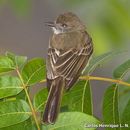en
names in breadcrumbs


The short-crested flycatcher (Myiarchus ferox) is a species of bird in the tyrant flycatcher family Tyrannidae.
It is found in Argentina, Bolivia, Brazil, Colombia, Ecuador, French Guiana, Guyana, Paraguay, Peru, Suriname, Uruguay, and Venezuela. Its natural habitats are subtropical or tropical moist lowland forests and heavily degraded former forest.
The short-crested flycatcher was formally described in 1789 by the German naturalist Johann Friedrich Gmelin in his revised and expanded edition of Carl Linnaeus's Systema Naturae. He placed it with the flycatchers in the genus Muscicapa and coined the binomial name Muscicapa ferox.[2] The specific epithet ferox is from Latin and means "brave", "wild" or "fierce".[3] Gmelin based his description primarily on "Le tyran de Cayenne" that had been described in 1760 by the French zoologist Mathurin Jacques Brisson. Brisson had examined both male and female specimens that had been sent to France from Cayenne.[4][5] The short-crested flycatcher is now one of 22 flycatchers placed in the genus Myiarchus that was introduced in 1844 by Jean Cabanis.[6] Within the genus Myiarchus, the short-crested flycatcher is genetically closely related to the Panama flycatcher (Myiarchus panamensis).[7]
Three subspecies are recognised:[6]
The short-crested flycatcher (Myiarchus ferox) is a species of bird in the tyrant flycatcher family Tyrannidae.
It is found in Argentina, Bolivia, Brazil, Colombia, Ecuador, French Guiana, Guyana, Paraguay, Peru, Suriname, Uruguay, and Venezuela. Its natural habitats are subtropical or tropical moist lowland forests and heavily degraded former forest.